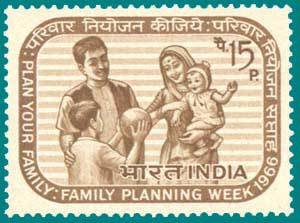Family planning in India
Family planning in India refers to the efforts and policies implemented by the Indian government and various organizations to control the population growth and improve reproductive health. India was one of the first countries in the world to initiate a national family planning program in 1952. The program has evolved over the decades, focusing on various methods of contraception, education, and health services to promote smaller family norms.
History[edit | edit source]
The family planning program in India began in 1952, making it the first country to launch such an initiative at a national level. Initially, the program focused on promoting the use of contraceptives and educating the public about the benefits of smaller families. Over the years, the program has expanded to include a wide range of services, including maternal and child health care, reproductive health services, and education on sexually transmitted infections (STIs).
Methods of Family Planning[edit | edit source]
The family planning program in India offers a variety of contraceptive methods, including:
- Condoms: Widely promoted as a barrier method to prevent both pregnancy and STIs.
- Oral contraceptive pills: Available through government health centers and private providers.
- Intrauterine devices (IUDs): Offered as a long-term contraceptive option.
- Sterilization: Both male (vasectomy) and female (tubal ligation) sterilization are available, with female sterilization being more common.
- Injectables and implants: Newer methods that are being introduced and promoted.
Challenges[edit | edit source]
Despite the long history of family planning efforts, India faces several challenges:
- Cultural and religious beliefs: These can influence attitudes towards contraception and family size.
- Access to services: Rural and remote areas may have limited access to family planning services.
- Gender inequality: Women's autonomy in making reproductive choices can be limited.
Impact[edit | edit source]
The family planning program has had a significant impact on India's demographic trends. The total fertility rate (TFR) has declined from around 6 children per woman in the 1950s to approximately 2.2 in recent years. This decline has contributed to slower population growth and improved health outcomes for women and children.
Symbols and Campaigns[edit | edit source]
The red triangle is a widely recognized symbol of family planning in India. It represents the government's commitment to promoting family planning and reproductive health.
Also see[edit | edit source]
References[edit | edit source]
- Ministry of Health and Family Welfare, Government of India
- National Family Health Survey (NFHS)
- World Health Organization (WHO)
| Sexual and reproductive health | ||||||||||
|---|---|---|---|---|---|---|---|---|---|---|
|
Search WikiMD
Ad.Tired of being Overweight? Try W8MD's physician weight loss program.
Semaglutide (Ozempic / Wegovy and Tirzepatide (Mounjaro / Zepbound) available.
Advertise on WikiMD
|
WikiMD's Wellness Encyclopedia |
| Let Food Be Thy Medicine Medicine Thy Food - Hippocrates |
Translate this page: - East Asian
中文,
日本,
한국어,
South Asian
हिन्दी,
தமிழ்,
తెలుగు,
Urdu,
ಕನ್ನಡ,
Southeast Asian
Indonesian,
Vietnamese,
Thai,
မြန်မာဘာသာ,
বাংলা
European
español,
Deutsch,
français,
Greek,
português do Brasil,
polski,
română,
русский,
Nederlands,
norsk,
svenska,
suomi,
Italian
Middle Eastern & African
عربى,
Turkish,
Persian,
Hebrew,
Afrikaans,
isiZulu,
Kiswahili,
Other
Bulgarian,
Hungarian,
Czech,
Swedish,
മലയാളം,
मराठी,
ਪੰਜਾਬੀ,
ગુજરાતી,
Portuguese,
Ukrainian
Medical Disclaimer: WikiMD is not a substitute for professional medical advice. The information on WikiMD is provided as an information resource only, may be incorrect, outdated or misleading, and is not to be used or relied on for any diagnostic or treatment purposes. Please consult your health care provider before making any healthcare decisions or for guidance about a specific medical condition. WikiMD expressly disclaims responsibility, and shall have no liability, for any damages, loss, injury, or liability whatsoever suffered as a result of your reliance on the information contained in this site. By visiting this site you agree to the foregoing terms and conditions, which may from time to time be changed or supplemented by WikiMD. If you do not agree to the foregoing terms and conditions, you should not enter or use this site. See full disclaimer.
Credits:Most images are courtesy of Wikimedia commons, and templates, categories Wikipedia, licensed under CC BY SA or similar.
Contributors: Kondreddy Naveen, Prab R. Tumpati, MD



